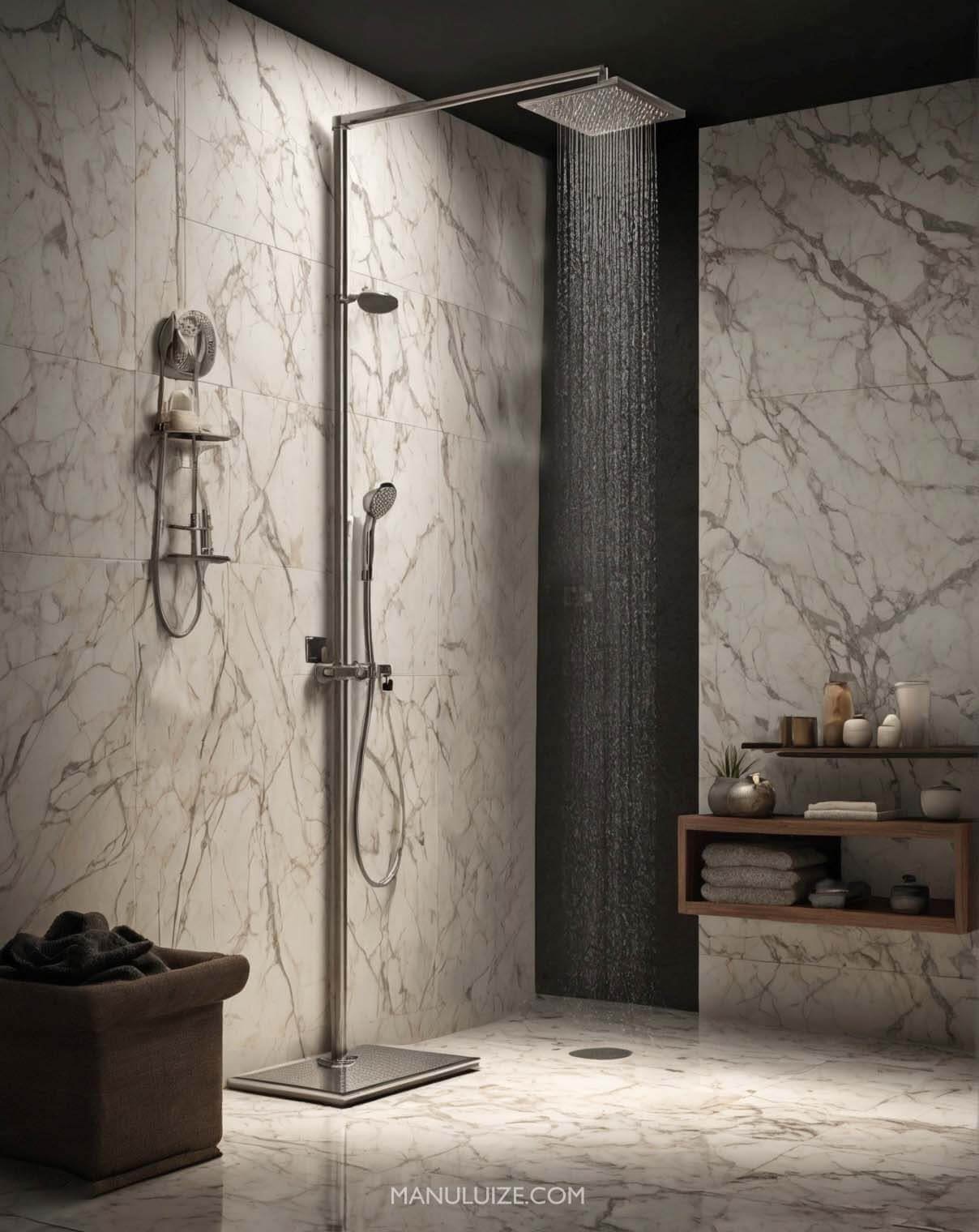In any bathroom project, the importance of a properly installed shower base cannot be overstated. As specialists in bathroom installation and design, we understand the crucial role that a well-installed shower base plays in the overall functionality and aesthetics of the space.
The installation process of a shower base involves several key steps, from preparing the installation area to securing and sealing the base in place. It requires careful attention to detail and the use of appropriate tools and materials to ensure a seamless result.
In this article, the bathroom installers Ability Bathe Devon will guide you through the essential steps to prepare the installation area for a shower base, ensuring a stable and long-lasting setup. We will also detail how to choose the right shower base, install the drain assembly, and secure and seal the base effectively to prevent leaks and ensure functionality.

Prepare the Installation Area
Before embarking on the installation of a shower base, thorough preparation of the installation area is essential. This initial step sets the foundation for a successful and long-lasting installation.
Begin by ensuring that the subfloor is level, as any unevenness can result in an unstable or improperly draining shower base. Use a level tool to check for any discrepancies and make necessary adjustments to achieve a level surface. Additionally, it’s crucial to clean the subfloor thoroughly, removing any dust, dirt, or debris that could interfere with the installation process.
Accurate measurements of the installation area are paramount to ensure a well-fitted shower base. Measure the dimensions of the space carefully, taking into account any alcoves or protrusions that may affect the placement of the shower base. Proper planning at this stage can help prevent costly mistakes and ensure that the shower base fits snugly into the designated area.
Consider the location of the drain in relation to the shower base and ensure that it aligns properly with the existing plumbing. If necessary, make adjustments to the drain placement to accommodate the chosen shower base.
In addition to the subfloor, inspect the surrounding walls for any damage or imperfections that may need to be addressed before proceeding with the installation. Repair any cracks or holes and ensure that the walls are sturdy and capable of supporting the weight of the shower base.
Select the Right Shower Base
Choosing the right shower base is a critical step in the installation process, as it determines the functionality, durability, and aesthetics of the shower enclosure. When selecting a shower base, several factors need to be considered to ensure it meets the specific requirements of the bathroom space.
First and foremost, consider the size of the shower base in relation to the available space in the bathroom. Measure the dimensions of the shower area carefully, taking into account any alcoves, corners, or obstructions that may affect the placement of the base. Opt for a base size that provides ample room for comfortable showering while still allowing for easy access and movement within the bathroom.
Next, consider the material of the shower base. Common materials include acrylic, fiberglass, and porcelain enamel on steel. Each material has its own set of advantages and considerations in terms of durability, maintenance, and cost. Choose a material that suits your budget and maintenance preferences while also complementing the overall design aesthetic of the bathroom.
Pay close attention to the location of the drain in relation to the shower base. Ensure that the base you select is compatible with the existing plumbing layout and that the drain aligns properly with the designated drainage hole. This will help prevent installation complications and ensure proper water drainage during use.
Additionally, consider the intended wall materials and shower door or curtain configuration when selecting a shower base. Choose a base that is compatible with the type of walls in your bathroom, whether they are tiled, acrylic, or another material. Similarly, ensure that the base is compatible with the chosen shower door or curtain setup to create a cohesive and functional shower enclosure.
Install the Drain Assembly
Installing the drain assembly is a crucial step in the shower base installation process, as it ensures proper water drainage and prevents leaks. Follow these steps to successfully install the drain assembly:
Position the Drain Pipe
Begin by positioning the drain pipe in the designated location on the subfloor. Ensure that the drain pipe aligns with the drainage hole in the shower base. Use a level to confirm that the drain pipe is positioned correctly and that it slopes slightly toward the drainage hole for efficient water flow.
Connect to the Existing Plumbing System
Once the drain pipe is in place, connect it to the existing plumbing system. Depending on the type of drain assembly and plumbing configuration, this may involve using compression fittings, solvent cement, or threaded connections. Follow the manufacturer’s instructions and local plumbing codes to ensure a secure and watertight connection.
Create a Watertight Seal
After connecting the drain pipe to the plumbing system, it’s essential to create a watertight seal around the drain connection. Apply plumber’s putty or silicone sealant to the underside of the drain flange before inserting it into the drain hole in the shower base. Tighten the drain flange securely using the appropriate tools to compress the sealant and create a watertight bond.
Test for Leaks
Once the drain assembly is installed, test for leaks by running water through the drain and checking for any signs of water escaping. If leaks are detected, tighten the connections or reapply sealant as needed to achieve a secure seal.
Set the Shower Base in Place
Once the preparation work is complete, it’s time to set the shower base in place. Follow these steps to ensure a successful installation:
Align with the Drainpipe
Carefully position the shower base over the drainpipe, ensuring that it aligns correctly with the drainage hole. Verify that the base sits securely on the subfloor and makes full contact with the floor surface.
Check Surrounding Walls
Ensure that the shower base aligns properly with the surrounding walls. Use a level to confirm that the base is horizontal and plumb on all sides. Adjust as needed to achieve proper alignment.
Secure the Base
Once the shower base is aligned correctly, secure it in place using the recommended installation method. This may involve screwing the base to the subfloor, applying adhesive or mortar, or using adjustable feet for support.
Ensure Stability
Verify that the shower base is stable and level. A level installation is essential for proper water drainage and to prevent any pooling or standing water in the shower area.
Check for Movement
Test the stability of the shower base by applying gentle pressure from different angles. Ensure that the base remains firmly in place without any movement or shifting.
Secure and Seal the Shower Base
Securing and sealing the shower base is crucial to prevent any movement and ensure a watertight enclosure. Here’s how to do it effectively:
Securing the Base
Depending on the type of shower base and the manufacturer’s recommendations, secure it in place using the appropriate method. This may involve using screws to attach it to the subfloor, applying adhesive or mortar beneath the base, or utilizing adjustable feet for support. Follow the manufacturer’s instructions carefully to ensure a secure installation.
Sealing the Edges
Once the shower base is securely in place, seal the edges around the base with silicone sealant. Apply a generous bead of silicone along the perimeter where the base meets the walls and floor. Use a caulking gun to ensure even application and smooth out the sealant with a caulking tool or your finger. This creates a waterproof barrier that prevents water from seeping underneath the base and causing damage to the subfloor.
Finishing Touches and Maintenance

Once the shower base is installed, it’s time for the finishing touches to complete the project and ensure its longevity:
Wall Panels or Tiles
Install wall panels or tiles around the shower area to create a waterproof surface that complements the shower base. Choose materials that are resistant to water and easy to clean for added durability and aesthetic appeal.
Shower Door or Curtain
Install the shower door or curtain according to the manufacturer’s instructions. Ensure that the door or curtain fits properly and provides adequate coverage to prevent water from splashing outside the shower enclosure.
Regular Cleaning and Maintenance
To maintain the cleanliness and functionality of the shower base, establish a regular cleaning routine. Use mild, non-abrasive cleaners to remove soap scum, dirt, and grime from the surface. Avoid harsh chemicals or abrasive scrubbers that could damage the finish of the base.
Inspect for Leaks
Periodically inspect the shower base and surrounding areas for any signs of leaks or water damage. Look for cracks, gaps in the sealant, or water stains on the walls or floor. Address any issues promptly to prevent further damage and maintain the integrity of the installation.
Conclusion
In conclusion, installing a shower base requires meticulous preparation, precise measurements, and proper sealing techniques to ensure a successful outcome. By following the steps outlined in this guide and paying attention to detail, homeowners can achieve a durable and functional shower base that enhances their bathroom renovation. However, if unsure or uncomfortable with the process, it’s advisable to seek professional assistance to guarantee a seamless installation. With a well-installed shower base, homeowners can enjoy the benefits of a beautiful and efficient bathroom space for years to come.






